原文 PDF:https://ww1.microchip.com/downloads/aemDocuments/documents/FTD/tekron/tekronwhitepapers/221223-A-guide-to-IRIG-B.pdf
IRIG-B3
概论
Inter-Range Instrument Group 时间码(简称IRIG)是一系列标准时间码格式。用于将时间信息(时间,日期,质量等)从 GPS/原子钟 传输到连接的从设备。
IRIG 标准在 1956 年由美国军方首次起草并于 1960 年正式推出,至今已成为一个定义明确的定时信号,多年来已被广泛采用和改进。
IRIG 时间码的应用范围从同步变电站自动化系统到军事通信和海洋测量设备。
IRIG有 6 种定义的格式(如下图 1)可供选择,创造了一种灵活而准确的计时格式,适用于所有行业。
The Inter-Range Instrument Group time code (or IRIG for short), is a range of standard time code formats which are used to transfer timing information (time, date, quality, etc) from a GPS/ Atomic clock to connected slave devices. With the IRIG standard first being drafted in 1956 and accepted in 1960, it’s now a well-defined timing signal which has been widely adopted and improved over the years. The applications for IRIG’s time codes range from synchronising substation automation systems to military communications and marine measurement equipment. With 6 defined formats to select from, IRIG have created a flexible and accurate timing format to work across all industries. The complete range of IRIG time code formats can be seen in figure 1.
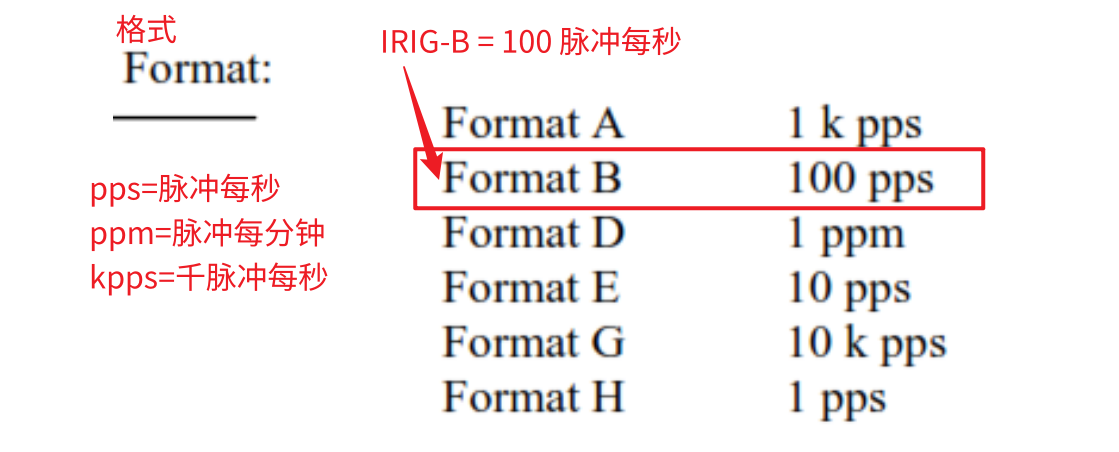
其中 IRIG-B 格式是最值得关注的。IRIG-B 是电力、工业自动化和控制行业中最常用的版本。
如图 1 所示:IRIG-B 是一个 100 Hz 的信号,每一帧包含 100 位数据,每个数据在 10 ms 的时间帧内传输,完成一帧传输的总时间为 1 秒(下表是信号相关参数表)
The time code that is worth focusing on is the IRIG-B format. IRIG-B is the most common version used within the Power, industrial automation and control industries. Referring to figure 1, IRIG-B is a 1 kHz signal which contains 100 bits of data, each transmitted over a 10 ms time frame, taking a total time of 1 second for a complete transmission (what amouthful…refer to table 1 for a summary)
| 编码 Code | 比特率 Bit Rate | 每比特时间 Bit Time | 每帧的比特数 Bits per Frame | 帧时间 Frame Time | 帧速率 Frame Rate |
|---|---|---|---|---|---|
| IRIG-B | 100 Hz | 10 ms | 100 | 1000 ms(1s) | 1 Hz |
在 IRIG-B 中,有一系列选项用于组成完整的信号。下面的小结将介绍这些选项。
Within IRIG-B there are a range of options available to make up the complete signal.
IRIG-B 信号格式
IRIG-B 调制类型
调制方式决定了实际输出信号的波形、表示 0/1信号的样式。IRIG-B具有三种不同的调制类型:
- 直流(DCLS):通常这是 0-5 V 直流脉宽调制信号,其中不同的脉宽表示编码数据。由于其高精度(时钟输出精度可 < 100 ns),这是当今最常用的调制方法。DCLS IRIG-B 信号的如图 2 中黄色的轨迹所示。
**Direct Current Level Shift (DCLS) **– typically this is a 0-5 Vdc pulse width modulated signal, where the different pulse widths represent coded data. This is the most common modulation method used today due to its high accuracy (< 100 ns at the port). An example of a DCLS signal is shown by the yellow trace in figure 2. - 载波调制–调幅(AM):用1 kHz 的正弦波载波信号以 3:1 的比例调制。此信号无直流成分,适合远距离传输,这使得AM 在过去很受欢迎。但由于信号精度较低(时钟输出精度 < 2μs),现在 AM 不再是首选。AM IRIG-B 信号的一个示例可以在图2中的绿色轨迹上看到。
**Amplitude Modulated (AM) **– modulated with a 1 kHz sine wave carrier signal with a 3:1 ratio, this signal has no DC content. This made AM popular in the past as it allowed the signal to be transmitted over long distances. Due to the low signal accuracy (< 2 microseconds at the port) AM is no longer the signal of choice. An example of an AM IRIG-B signal can be seen on the green trace in figure 2. - AM 调制 + 曼彻斯特编码:使用1 kHz 的方波作为载波;使用相位调制而不是 DCLS(曼彻斯特编码),该信号不包含直流偏置。这种调制方法可长距离传输,并时保持高精度(时钟精度 <100 ns)。这种调制方法是 IRIG-B最不常见的调制类型。
Modified Manchester Modulation – Modified Manchester modulation is the least common modulation type for IRIG-B. Using a 1 kHz square wave with phase modulation rather than DC level shift, this signal contains no DC bias. This allows for transmission over long distances, while maintaining a high accuracy (<100 ns)
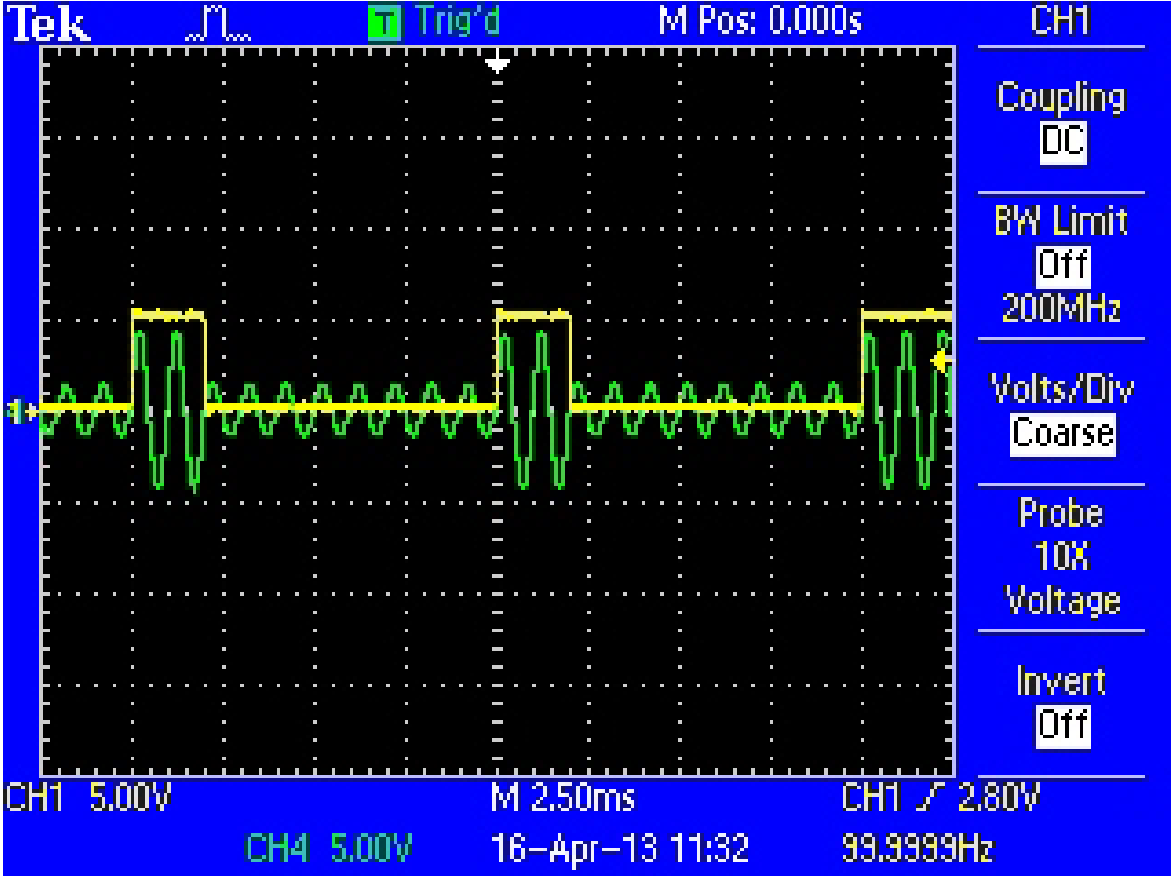
每种调制方式的精度和传输特性总结在下表中
The accuracy and transmission characteristics of each modulation type are summarised in table 2.
| 调制方式 Modulation Type | 最大传输距离 Maximum Transmission Distance | 精准度(时钟端口处的输出) Accuracy (at clock port) | |
|---|---|---|---|
| 0 | 直流 DCLS | < 100 m | < 100 ns |
| 1 | 载波调制–调幅 AM | < 300 m | < 2 μs |
| 2 | AM + 曼彻斯特编码 | < 300 m | < 100 ns |
这些调制类型前面的数字(0,1,2)用于组成【IRIG-B 格式代码】。格式代码通常表示为 IRIG-Bxyz 或 Bxyz
The number in front of these modulation types (0,1,2) make up the IRIG-B format code, which is generally presented as IRIG-Bxyz or Bxyz.
在该代码中,x = 调制方式,y = 载波频率,z = 编码表达式
In this code x is the modulation type, y is the carrier frequency and z is the coded expressions or information that is included within the IRIG message.
为了组成完整的格式代码,还需要确定【载波频率】和【编码表达式】的不同选项。
To make up the full expression, we must now look at the different options for the carrier frequency and the coded expression.
载波频率
【载波频率】取决于所使用的【调制类型】。
For IRIG-B, the carrier frequency will depend on the modulation type that is being used.
对于 IRIG-B,有两种常见的载波频率:
The two common carriers in IRIG-B are:
- 无载波 – 直流(DCLS IRIG-B)不需要载波调制,因此没有载波频率
No carrier – DCLS requires no carrier frequency - 1 kHz载波 --【AM 调制】和【AM + 曼彻斯特编码】通常使用 1 kHz载波
1 kHz carrier – AM and Modified Manchester both commonly use a 1 kHz carrier
综上,有三种 IRIG-B 格式代码:
- IRIG-B00z – 没有载波 --> 直流 IRIG-B 信号(DCLS IRIG-B)
IRIG-B00z – This is a DCLS IRIG-B signal with no carrier. - IRIG-B12z – 调幅(AM)信号,载波为1 kHz正弦波(AM IRIG-B)
IRIG-B12z – This is an amplitude modulated (AM) signal with a 1 kHz carrier sine wave - IRIG-B22z – AM + 曼彻斯特编码的 IRIG-B 信号
IRIG-B22x – This is the modified Manchester modulation type with a 1 kHz square wave carrie
IRIG-B 编码表达式
编码方式决定了如何表达时间、表达哪些信息(类似时间中的内容:中式时间为年月日,而美式时间为月日年)
IRIG-B 格式代码包含最后一部分信息,是编码表达式,也被认为是信号中包含的信息。
The final section of the IRIG-B code to consider is the Coded Expressions, also thought of as the information contained in the signal.
这里在下表 3 中定义 IRIG-B 中不同编码内容使用的缩略词。编码内容的组合形成了编码表达式
| 缩写 Acronym | 全称 Name | 定义 Definition |
|---|---|---|
| BCDTOY | BCD编码的时间(一年中的第几天) Binary coded Decimal – Time of Year | 使用 BCD 编码,包含以下信息:秒、分、时、一年中的第几天 BCDTOY contains the following information: seconds, minutes, hours, day of year |
| BCDYEAR | BCD编码的年份 Binary Coded Decimal – Year | 使用 BCD 编码,显示年份(范围 0-99) BCDYEAR contains the year value (0-99) |
| CF | 控制功能 Control Function | 控制功能是IRIG-B代码的空白部分,可以用用户定义的控制字段填充。更多内容请见《控制功能》小节 Control functions are a blank section of the IRIG-B code that can be filled with user defined control fields. More about this in the extensions section |
| SBS | 二进制秒数 Straight Binary Seconds | 直接显示一天到现在到当前时间经过的秒数。范围 0-86399。可用来获取一天中的具体时间,也可用作检查 SBS counts from 0 to 86,399. This is the number of seconds that have passed during the day. This can be used to get time of day also, and is sometimes used as a check |
了解了不同的首字母缩略词后,我们现在可以列出 IRIG-B 时间码的 8 种【编码表达式】(见下表)。
With an understanding of the different acronyms, we can now look at the seven data options available to make up the IRIG-B time code. The options are listed in table 4.
| 编号 z = Code | 表达式 Expression | 详情 Details |
|---|---|---|
| 0 | BCDTOY , CF, SBS | 秒,分,时,一年中的第几天,控制指令,二进制秒数 |
| 1 | BCDTOY , CF | 秒,分,时,一年中的第几天,控制指令 |
| 2 | BCDTOY | 秒,分,时,一年中的第几天 |
| 3 | BCDTOY , SBS | 秒,分,时,一年中的第几天,二进制秒数 |
| 4 | BCDTOY, BCDYEAR, CF, SBS | 秒,分,时,一年中的第几天,年份,控制指令,二进制秒数 |
| 5 | BCDTOY, BCDYEAR, CF | 秒,分,时,一年中的第几天,年份,控制指令 |
| 6 | BCDTOY, BCDYEAR | 秒,分,时,一年中的第几天,年份 |
| 7 | BCDTOY, BCDYEAR, SBS | 秒,分,时,一年中的第几天,年份,二进制秒数 |
这些表达式中的每一个最常见的是【4号数据】,它包含所有的定时信息和控制字段。这将确保无论您使用什么设备,它都可以接收到与主时钟同步所需的所有信息。对于不需要的额外信息,从设备可以自行丢弃。
The most common option for each of these expressions is code 4, which contains all the timing information and control fields. This will ensure that no matter what device you are using, it can receive the information that it requires to sync to the master clock. For the devices that do not need the extra information, this should be discarded by the slave device.
综上,以上示例组成了部分常用的 IRIG-B 格式代码:
This the brings up to the complete IRIG-B formats:
- IRIG-B004 – 没有载波、传送完整信息的 IRIG-B 信号(DCLS IRIG-B 信号,传送 4 号数据)
IRIG-B004 – This is a DCLS IRIG-B signal with no carrier - IRIG-B124 – 使用载波调幅(AM)、载波为1 kHz正弦波、传送 4 号数据的 AM IRIG-B 信号
IRIG-B124 – This is an amplitude modulated (AM) signal with a 1 kHz carrier sine wave - IRIG-B224 – 使用曼彻斯特编码、载波为 1 kHz方波、传送 4 号数据的 IRIG-B 信号
IRIG-B224 – This is the modified Manchester modulation type with a 1 kHz square wave carrier
总结:IRIG-B 格式代码
IRIG-B 格式代码,通常表示为 IRIG-Bxyz 或 Bxyz
The IRIG-B format code is generally presented as IRIG-Bxyz or Bxyz.
在该代码中,x = 调制方式,y = 载波频率,z = 编码表达式
In this code x is the modulation type, y is the carrier frequency and z is the coded expressions or information that is included within the IRIG message.
下图(图 3)是 IRIG-B 标准规范中对格式代码的规定。
if you are looking for a quick reference guide to all this information, please refer to figure 3. This perfectly summarises all the options available in the IRIG range.
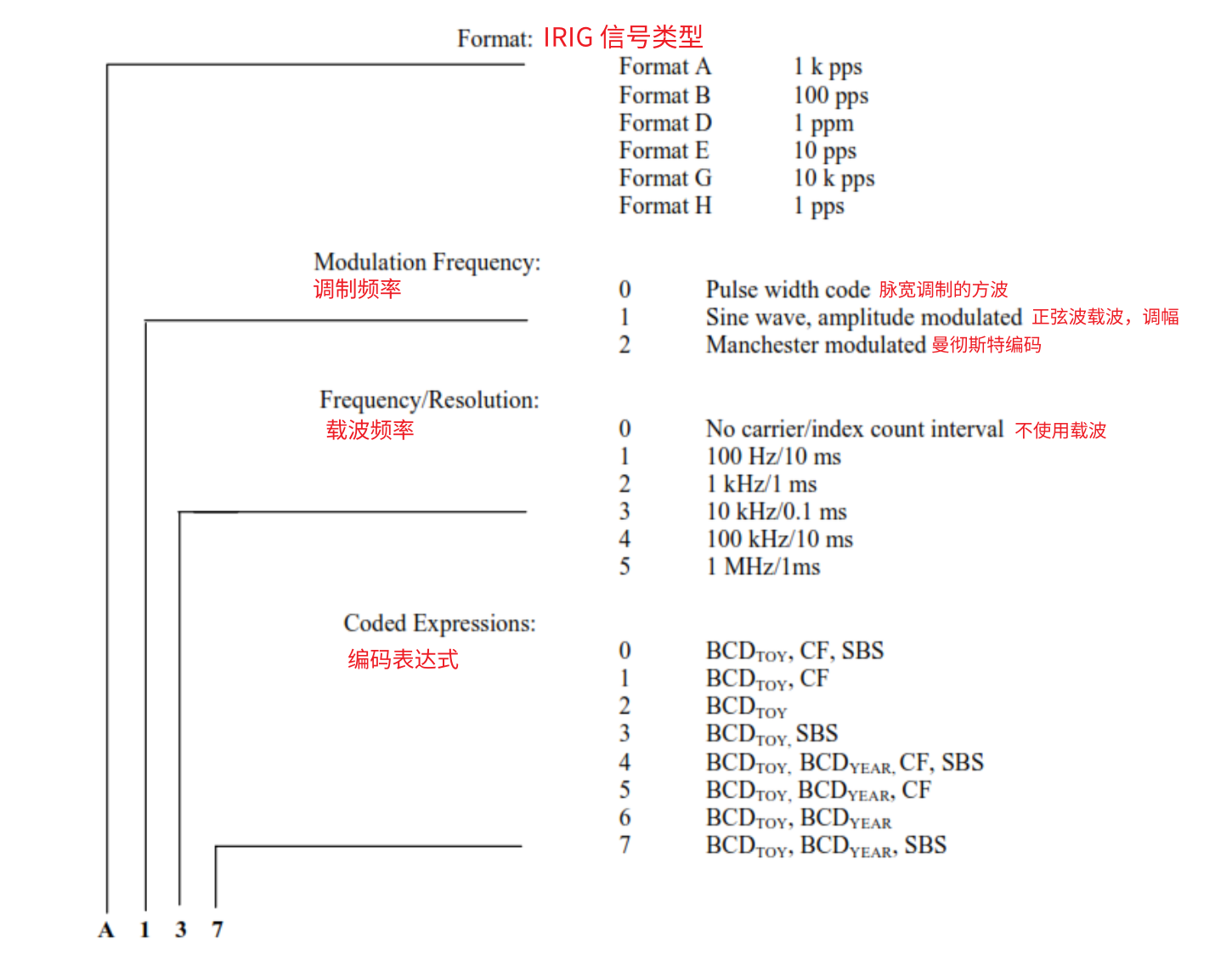
IRIG-B 信号报文
物理IRIG-B信号由几个关键属性组成。了解这些属性并不重要,有助于全面了解 IRIG-B 信号的工作原理。也有助于在示波器上查看、分析 IRIG-B 信号。
起始标志
在直流 IRIG-B 信号(DCLS IRIG-B)中,起始标志是一个8 ms的脉冲。该 8 ms 脉冲标志着 IRIG-B 码的开始,并为从设备提供时钟信号的校准对齐。
The first point we are interested in is the reference marker which is found at the start of the signal. In the case of a DCLS signal, this reference marker is an 8 ms pulse which has its rising edge at the on second mark (when the second starts). This 8 ms pulse marks the start of the IRIG-B code, and gives a second pulse reference for slave equipment to align to.
找到准时参考标记的最简单方法是寻找两个并排的 8 ms脉冲。第一个脉冲是上一个 IRIG-B 帧的结束,第二个脉冲是新 IRIG-B 帧的开始。这种脉冲的一个例子如下图 4 所示。
The easiest way to find the on-time reference marker is to look for the two 8 ms pulses which are side by side. The first is the end of the trailing IRIG-B frame, and the second is the on-time marker starting the new IRIG-B frame. An example of this pulse is shown in figure 4.
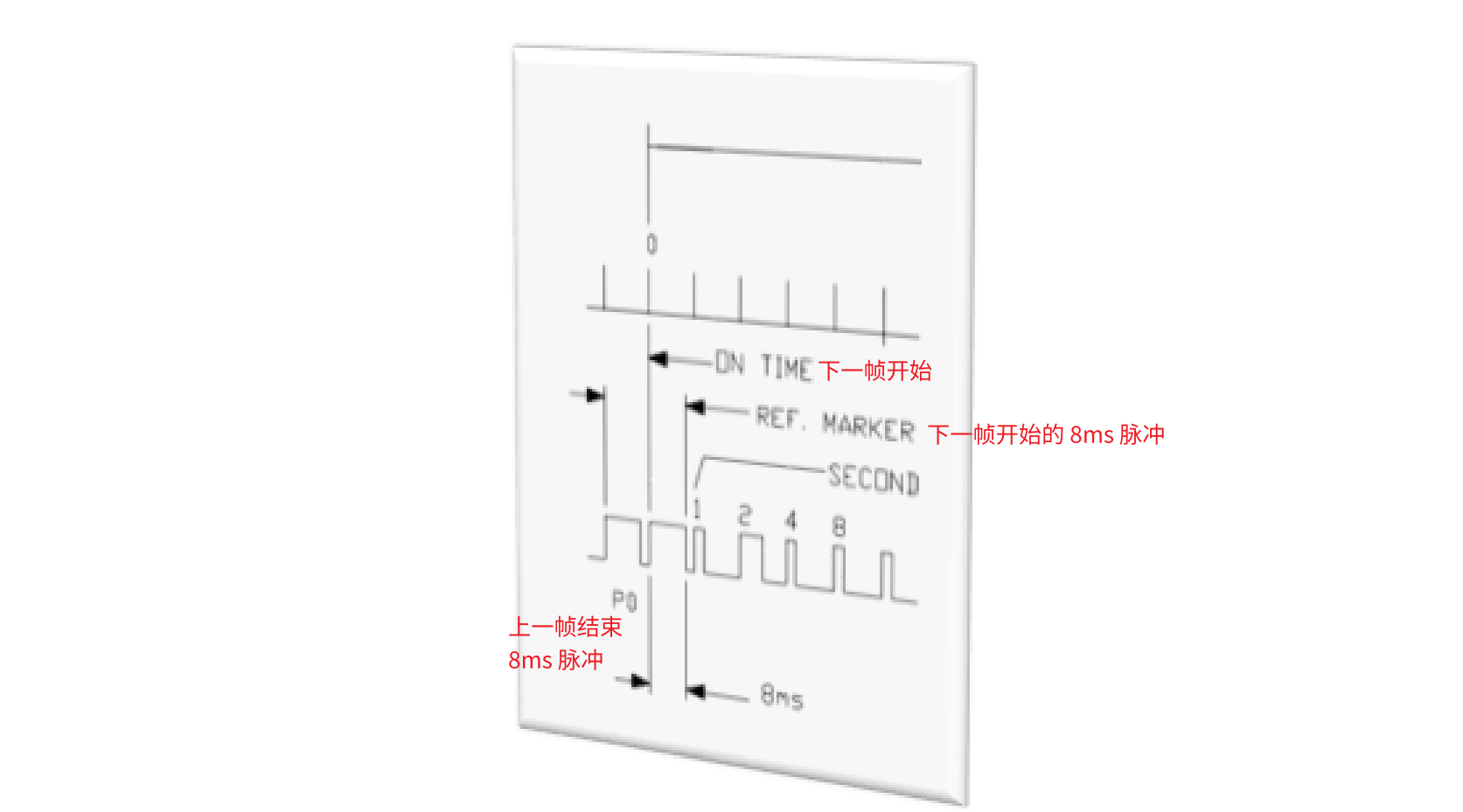
信号报文
. you will note that , and
起始标志后,紧跟着其他报文(见图 5)。这里以直流 IRIG-B 编码(DCLS IRIG-B)为例(调制信号解调后报文结构相同)
- 时间信息的 BCD 码数被分成 10 个字节
From the reference marker come the binary coded decimals which are split into ten 8-bit groups. - 每个字节间被 8 ms 的位置标识符(P1 至 P0)分隔
Each divided by 8 ms position identifiers (P1 to P0). - 数据使用不同的脉冲宽度(脉宽调制)来编码
The data contained in these blocks are coded using different pulse widths to represent either a binary 0 or a binary 1- 二进制 0 = 2 ms 宽度的脉冲
A binary “0” is represented by a 2 ms pulse. - 二进制 1 = 5 ms 宽度的脉冲
A binary “1” is represented by a 5 ms pulse.
- 二进制 0 = 2 ms 宽度的脉冲
- 获取位置标识符(Px)之间的所有位,可将 BCD 格式的二进制转换为十进制值,获得正确的时间和日期
Taking all the bits between the position identifiers, you can convert binary to a decimal value to get the correct time and date. - 秒、分、小时和年字段被分成两个 4 位部分。
The seconds, minutes, hours and year field are broken into two 4-bit sections.- 前四位表示小数 0-9
The first four bits represent decimals 0-9. - 后四位表示该数字整 10 倍,即 10、20、30、40、50
The next four bits representing the 10’ s of that number – 0, 10, 20, 30, 40, 50.
- 前四位表示小数 0-9

具体每一位表示的内容如下
Please refer to table 5 for the full details.
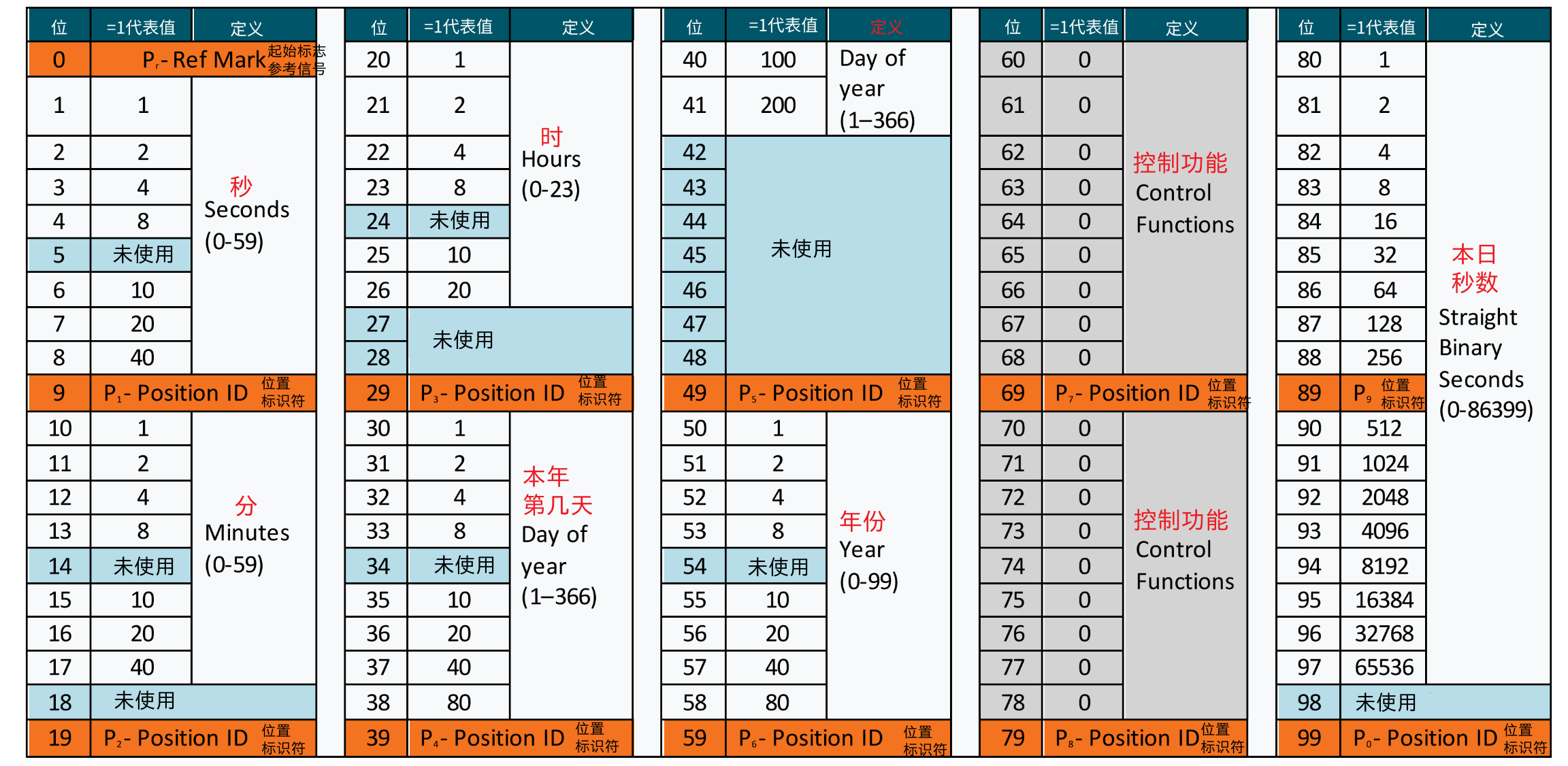
控制功能
在 IRIG-B 信号中,有 16 位是 IRIG 标准之外的用户定义位。
Within the IRIG-B signal, there are 16 bits available for user defined bits which are outside of the IRIG standard.
这些控制功能可以包含一些其他信息,如:时钟源的健康状况,闰秒是否待定,夏令时偏移等。
These control functions can contain several key fields which can tell you the health of the clock, if a leap second is pending, or the daylight savings offset.
的两个关键标准是法国 AFNOR 标准和 C37.118.1 标准。这两种标准解析如下。
The two key standards that define what these control bits should be are the AFNOR standard and the C37.118.1 Standard. Let’s look at what each of the standards offer in terms of control bits
法国扩展标准 AFNOR NFS 87-500
AFNOR 标准是一种法国标准,与 IRIG-B 代码非常相似,具有关于星期几,月份和月份的其他信息。
The AFNOR standard is a French standard that is very similar to the IRIG-B code, with additional information about the day of week, month and day of month.
尽管在电力行业中没有被广泛采用,但大多数时钟供应商仍然支持该标准。图 6 显示了AFNOR信号的结构。
Even though not widely adopted in the power industry, this standard is still supported by most clock vendors. Figure 6 shows the makeup of the AFNOR signal, with the extra fields added
- 控制功能部分添加了额外的两个字段:【月 Month (0-12)】、【每月第几天 Day of Month (0-31)】
- IRIG-B 中本年第几天最后一个字节未使用的位(42-48)用于显示星期(Day of Week 1-7)
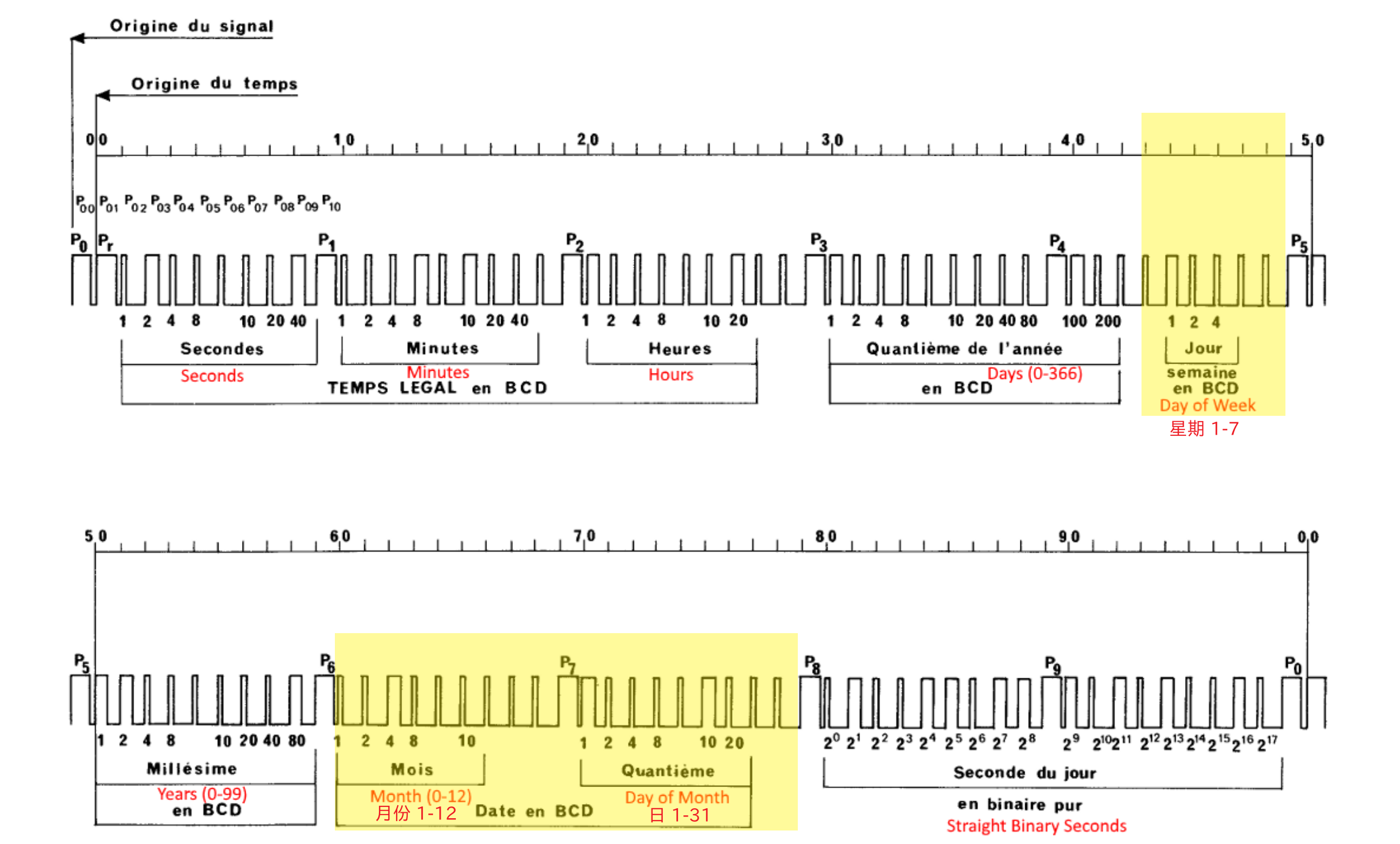
IEEE C37.118.1(取代 IEEE-1344 和 C37.118)扩展标准
同步相量测量装置(PMU)是利用全球定位系统(GPS)秒脉冲作为同步时钟构成的相量测量单元。可用于电力系统的动态监测、系统保护和系统分析和预测等领域。
PMU 在记录和比较样本时,对高精度、可靠的时间同步的需求极高。由于时钟不同步而导致的两个位置之间的定时误差可能导致错误跳闸,导致操作员做出错误且可能代价高昂的决策。
With the introduction of Phasor Measurement Units (PMUs), the need for high accuracy, reliable time stamping became a strict requirement when recording and comparing samples. Timing errors between two locations due to an unsynchronised clock could result in false tripping, causing operators to make incorrect and potentially costly decisions.
用于同步相位测量的 IEEE C37.118.1 标准于 2018 年更新,取代了之前的标准 IEEE C37.118.1-2011、IEEE 37.118(2005)和 IEEE 1344(1995)。这些标准不断更新迭代,以满足对电流、频率、负载、电压等参数的真实的实时监测需求。
The IEEE C37.118.1 standard for Synchrophasor Measurements for Power Systems was released in 2011, superseding the previous standard C37.118 (2005) and the IEEE 1344 (1995) standards. Each of these standards were released and improved to keep up with the need for real time monitoring of parameters such as current, frequency, load, voltage and so on to avoid blackouts.
由于IRIG-B是单向信号,即没有来自从设备的时钟反馈,因此需要向 IRIG-B 代码中添加附加字段,以允许从设备决定定时源是否满足其精度要求,并在报告的精度过低时不做同步。这导致 IEEE 标准使用控制字段,下表中的字段被添加到信号中。
With IRIG-B being a one-way signal, i.e. no feedback to the clock from the slave, additional fields needed to be added to the IRIG-B code to allow the slave devices to decide if the timing source meets their accuracy requirements, and to stop operating if the reported accuracy was too low. This brought about the use of the control fields by the IEEE standards, with the fields in table 6 being added to the signal.
以下是 IEEE 标准中在控制功能中额外添加的内容
Overview of the control bits added in the IEEE specifications.
| 位 Bit | =1值含义 Value | 定义 Definition | |
| 60 | 0 | 闰秒补偿发生 LSP:在插入/删除跳跃之前,该位在 59 秒内变为 1,事件发生后清0。 Leap Second Pending – This field becomes a 1 up to 59 seconds BEFORE a leap is inserted/ deleted. Returns to 0 after the event. | |
| 61 | 0 | 闰秒补偿模式 LS:0 = 加一秒(最常见),1 = 减一秒 Leap Second (LS) – 0 = Add a Second (most common) and 1 = Subtract a Second | |
| 62 | 0 | 夏令时切换发生 DSP:此位在进入夏令时前一分钟变为 1。进入夏令时后清 0。 Daylight Saving Pending (DSP) – This field becomes a 1 up to 59 seconds BEFORE a DST event. Returns to 0 after the event. | |
| 63 | 0 | 夏令时 DST:1= 夏令时期间,0 = 不是夏令时 Daylight Savings Time (DST) – Becomes 1 during DST | |
| 64 | 0 | 时间偏移的符号:0 = 正偏移(+),1 = 负偏移(-) Time Offset sign – 0 = + and 1 = - | |
| 65 | 1 | 时间偏移:IRIG-B 时间相对 UTC 时间的偏移,即本地时区偏移。如北京在 UTC +8 时区,则 IRIG 时间 - 8 小时= UTC 时间 Time Offset - This is the offset from the IRIG-B time to UTC time i.e. the local time offset (+12 hr for NZ). Taking this offset, and the IRIG time you can get the UTC time. i.e IRIG time – 12 h = UTC time | |
| 66 | 2 | ||
| 67 | 4 | ||
| 68 | 8 | ||
| 69 | P7 - 位置标识符 Position ID | ||
| 70 | 0 | 时间偏移 0.5 小时(用于精确补偿时区):0 = 不偏移,1 = 启用偏移 Time offset 0.5 hours – 0 = No offset and 1 = 0.5-hour offset | |
| 71 | 1 | 时间质量 TQ:时钟源与 UTC 时钟源时间误差信息,4位数值表示。数值的具体含义,参见 TQ 章节。 Time Quality bit – this is a 4-bit code representation of the approximate clock time error from UTC. Refer to table 7 for the full range of values. | |
| 72 | 2 | ||
| 73 | 4 | ||
| 74 | 8 | ||
| 75 | 0 | 奇偶校验位:对报文 75 位及之前数据进行偶校验,以确保前面的数据不出错 Parity – this is the parity for preceding bits. Acts as a check to ensure the preceding data make sense. The parity bit will ensure EVEN parity is generated. | |
| 76 | 1 | 连续时间质量 CTQ:表示传输消息中的估计时间误差信息,3位数值表示。数值的具体含义,参见 CTQ 章节。Continuous Time Quality - This is a 3-bit code representation of the estimated time error in the transmitted message. Refer to table 8 for the full range of values. | |
| 77 | 2 | ||
| 78 | 4 | ||
| 79 | P8 - 位置标识符 Position ID | ||
时间质量(TQ)
TQ 字段给出了 IRIG-B 信号与 UTC 的时钟源根据“是否接通、断开间隔”给出的时间精度的指示。当时钟源与卫星处于锁定状态时(正常同步时),该值保持为0,当且仅当时钟失去与定位卫星的锁定时才会改变,并开始 TQ 计时。
The TQ field gives an indication of the time accuracy of the IRIG-B signal at the “on time”point relative to UTC. When in a locked state this value remains at 0, and will only change when the clock loses lock with the satellite constellations, entering holdover.
下表是 TQ 字段值的含义
Definition of the values available in the TQ field.
| 值 Value | 含义 Definition |
|---|---|
| 0 | 时钟锁定到 UTC 可追踪源(时钟与卫星实时同步) Clock is locked to a UTC traceable source |
| 1 | 与 UTC 的时间误差 < 1ns Time is within <1ns of UTC |
| 2 | 与 UTC 的时间误差 < 10ns Time is within <10ns of UTC |
| 3 | 与 UTC 的时间误差 < 100ns Time is within <100ns of UTC |
| 4 | 与 UTC 的时间误差 < 1μs Time is within <1μs of UTC |
| 5 | 与 UTC 的时间误差 < 10μs Time is within <10μs of UTC |
| 6 | 与 UTC 的时间误差 < 100μs Time is within <100μs of UTC |
| 7 | 与 UTC 的时间误差 < 1ms Time is within <1ms of UTC |
| 8 | 与 UTC 的时间误差 < 10ms Time is within <10ms of UTC |
| 9 | 与 UTC 的时间误差 < 100ms Time is within <100ms of UTC |
| 10 | 与 UTC 的时间误差 < 1s Time is within <1s of UTC |
| 11 | 与 UTC 的时间误差 < 10s Time is within <10s of UTC |
| 15 | 时钟故障,时间不可靠 Fault – Clock failure, time is not reliable |
连续时间质量(CTQ)
CTQ 字段给出 IRIG-B 信号在与 UTC 时钟源同步过程中估算的误差。
The CTQ field gives an indication of the time accuracy of the IRIG-B signal at the “on time”with respect to UTC for each IRIG-B message. CTQ was added to the IRIG-B signal to give an indication of accuracy when in sync as the Time Quality Indicator always shows 0 when in .sync
此字段在 IEEE 1344 标准中没有,在 C37.118 标准中添加。具体值含义见下表
This field was not available in the IEE1344 standard, being added to the later C37.118 standard. A full table of the available values is shown in table 8.
| 值 Value | 含义 Definition |
|---|---|
| 0 | 未使用(用于兼容旧版 IEEE 标准的位) Not used (indicates code from previous version of standard) |
| 1 | 时钟源时间误差 < 100ns Estimated maximum time error <100ns |
| 2 | 时钟源时间误差 < 1μs Estimated maximum time error <1μs |
| 3 | 时钟源时间误差 < 10μs Estimated maximum time error <10μs |
| 4 | 时钟源时间误差 < 100μs Estimated maximum time error <100μs |
| 5 | 时钟源时间误差 < 1ms Estimated maximum time error <1ms |
| 6 | 时钟源时间误差 < 10ms Estimated maximum time error <10ms |
| 7 | 时钟源时间误差 > 10ms 或时间误差位置 Estimated maximum time error > 10mS or time error unknown |
设计和安装建议
在安装和设计IRIG-B网络时,需要考虑一系列因素。
When installing and designing an IRIG-B network, there are a range of factors that need to be considered.
传输介质:屏蔽双绞线(STP) / 同轴电缆
IRIG-B 最常使用同轴电缆作为传输介质。通常,RG58 电缆用于传输直流或载波 IFIG-B 信号,因为它易于布线,易于串接终端电阻,且具有良好的屏蔽特性。
The most common implementations of IRIG-B throughout the world use coaxial cable as the transmission medium. Generally, RG58 cabling is used to carry both AM and DCLS signals, as it is easy to wire, easy to clip on termination resistors and has good shielding characteristics.
**其次最常见的是使用屏蔽双绞线(STP)电缆,比如标准以太网电缆。**屏蔽双绞线有几个优点,包括电缆屏蔽层、高传输速率、良好的屏蔽特性(特别是平衡对)、低电容特性。
The next most common is to use shielded twisted pair (STP) cabling like that found in a standard Ethernet cable – except with a braided shield around the outside of the cable. Shielded twisted pair has several benefits including high transmission rates, good shielding characteristics (especially with balanced pairs) and low capacitance characteristics.
如果只用于传输 IRIG-B 信号,哪种介质更好? STP,因为 STP 有较低的电缆电容。
In the case of the transmission of IRIG-B, which one is better? The answer is STP. The key reason as to why STP is better than coax, is the lower cable capacitance.
对于长距离传输的DCLS信号,电缆电容极其重要,因为高电容将导致信号边缘变圆。这样不仅影响信号的准确性,而且还可能导致一些从站设备错误读取信号,或完全拒绝信号。
For a DCLS signal being transmitted over a long distance the cable capacitance becomes important, as a high capacitance will cause the signals edges to become rounded. This rounding not only affects the signals accuracy, but may also cause some IEDs to falsely trip, or to reject the signal completely.
参考图7,可以看到高电缆电容的影响,IRIG-B信号的上升沿和下降沿开始变圆。
Referring to figure 7, the effects of a high cable capacitance can be seen with the rising and falling edges of the IRIG-B signal starting to become rounded.

电缆电容限制了单根信号线的长度。
- 对于 RG58 同轴电缆,建议在距离大于 50 m时安装信号中继器
- 对于 STP 屏蔽双绞线,建议在距离大于 100 m时安装信号中继器
终端电阻
对于直流 IRIG-B(DCLS IRIG-B)
安装IRIG-B线路时,需要在电缆线路的末端安装一个端接电阻器。
When installing an IRIG-B run, always install a terminating resistor at the end of the cable run.
尽管IRIG-B是一个相对较低的频率信号(1 kHz),但它仍然包含高频分量,可能导致信号反射。在线路末端添加一个终端电阻可防止这种情况发生,确保沿 IRIG-B 线路的沿着设备不会受到干扰。它还有助于抑制信号的高压过冲。
Even though IRIG-B is a relatively low frequency signal (1 kHz), it still contains high frequency components which can result in short wavelength signal reflections. Adding a terminating resistor to the end of the line stops this from occurring, and ensures that devices along the IRIG-B run are not disrupted. It also helps to dampen overshoot for high drive lines.
未端接线路的影响如图8所示。
The effects of an unterminated line can be seen in figure 8.
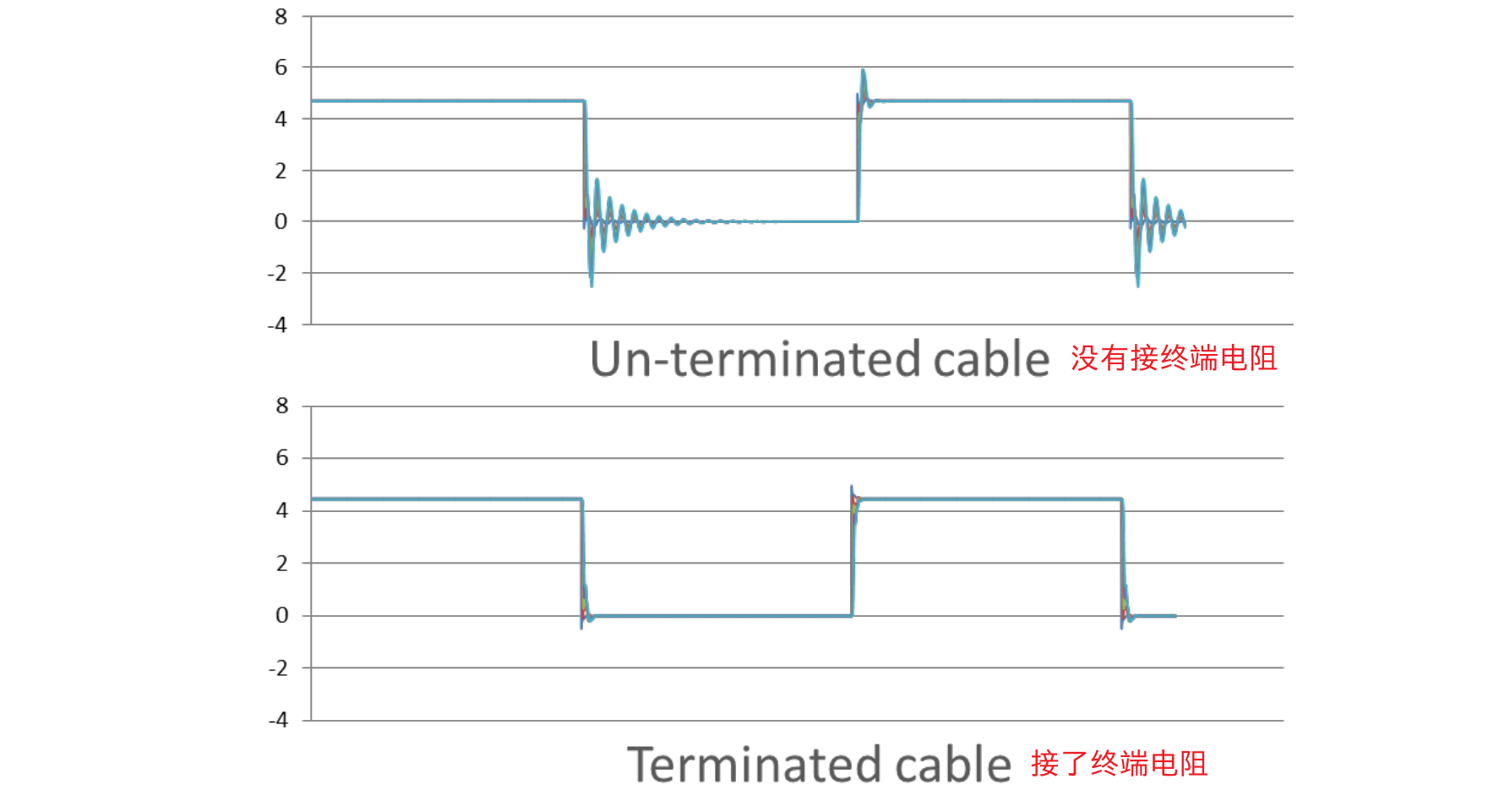
为直流 IRIG-B 信号选择端接电阻非常简单,只需将电阻与电缆的阻抗匹配即可。
Selecting a termination resistor for a DCLS cable run is quite simple, you just need to match the resistor to the impedance of the cable.
- 对于屏蔽双绞线电缆 STP ,电缆阻抗通常为120 Ω(如 Belden 9841)。
For a shielded twisted pair cabling, the cable impedance is usually 120 Ω (e.g. Belden 9841) - 对于同轴电缆,电缆阻抗取决于你使用的电缆类型。
For coaxial cable it will depend on what type of cable you use, as to the terminating resistor.- 对于RG 58,建议端接 50 Ω 电阻。
For RG58 you would expect to use a 50 Ω terminating resistor. - 对于RG 59,建议端接 75 Ω 电阻。
For RG59 a 75 Ω resistor.
- 对于RG 58,建议端接 50 Ω 电阻。
**在选择电阻器时,还需要考虑额定功率。**直流 IRIG-B 信号通常为 5 V,因此可以使用以下公式计算额定功率:
When selecting a resistor you will also need to consider the power rating. As DCLS is generally a 5 V DC signal, you can calculate the power rating easily using:
P = V 2 R P=\frac{V^{2}}{R} P=RV2
因此使用 E24 精度(5% 误差)、额定功率 > 0.5W 的电阻即可满足大多数要求。
Resistors above a 0.5 W rating in the E24 (5%) range will cover most requirements
在计算总线负载时,请记住将端接电阻考虑在内,以确保 IRIG-B 信号的输出不过载。
Remember to take the terminating resistor into account when calculating the bus loading, to ensure you do not overload an IRIG-B output.
对于调幅载波 IRIG-B(AM IRIG-B)
选择 AM IRIG-B 信号的端接电阻与选择直流信号的端接电阻略有不同。
Selecting a terminating resistor for AM IRIG-B is slightly different to that of a DCLS signal
可将端接电阻视为分压器,用于使线路电压与从设备的输入要求相匹配。
It’s better to think of the terminating resistor as a voltage divider, which is used to match the line voltage to the input requirements of the slave devices.
以下是一个终端电阻的计算示例:
To explain this, let’ s work through an example calculation!
如下图 9,您可以看到端接电阻连接在 IRIG-B 总线末尾的两端。此时它与成为了一个分压器,分到的电压还与时钟信号源的内阻、从设备的内阻共同决定。
Starting by looking at figure 9, you can see that the terminating resistor is attached across the line, at the end of the IRIG-B bus. By attaching it here it’s effectively creating a divider for which the ratio is defined by the total resistance of the line, as well as the clocks’ internal resistance.
在开始计算之前,需要收集以下信息(设终端电阻阻抗为 R t e r m R_{term} Rterm):
Before starting this calculation you will need to know the following information:
- 时钟输出的内部阻抗 R s R_s Rs。可在时钟源的手册中找到相关参数,这里以 120 Ω 为例。
The internal impedance of the clock’s output. In the case of Tekron’s range this is 120 Ω - 连接到 IRIG-B 总线上的每个从设备的输入阻抗 R 1 , R 2 , … , R n R_1, R_2, \dots, R_n R1,R2,…,Rn。可在从设备手册中找到相关参数,通常为 kΩ 级。这里设每个从设备的输入阻抗为 6 kΩ,连接 5 个从设备(n = 5)。
The input impedance of each IED that is connected to the IRIG-B bus. For most relays this will be in the range of kΩ’s. For this example we are assuming all the relays have a 6 kΩ input impedance. This can be found on most relay manufacturers datasheets. - 从设备接口允许的最大输入电压 V r e q V_{req} Vreq(峰-峰值),可在从设备手册中找到相关参数,范围通常为 5V 到 10V。
The input voltage requirements of the IED’s. This is where you need to determine the maximum voltage input that the relay allows. This can be anywhere from 5 Vdc to 10 Vdc. This can be found on most relay manufacturers datasheets. - 时钟源的输出电压 V o u t V_{out} Vout(峰-峰值),可在时钟源手册中找到相关参数。这里设定为 8 V。
he output voltage of the clock. In the case of Tekron this is 8 V.

基于以上信息,首先可计算 IRIG-B 总线上的总负载 R L R_L RL。由于它们是并联的,可列出方程如下:
Now that you have this information, the first step is to calculate the total load on the IRIG-B bus. This can be done by adding together all the input impedances of the slave devices. As they are connected in parallel we would expect the equation to look like this:
1 R L = 1 R 1 + 1 R 2 + ⋯ + 1 R n \frac{1}{R_L}=\frac{1}{R_1}+\frac{1}{R_2}+\dots+\frac{1}{R_n} RL1=R11+R21+⋯+Rn1
带入已知参数:有 3 个从设备,每个设备阻抗为 6 kΩ;时钟源内阻为 120 Ω
In our example, we have 5 protection relays each with an input impedance of 6 kΩ. This makes our equation:
1 R L = 1 R s + 1 R 1 + 1 R 2 + 1 R 3 = 1 6000 + 1 6000 + 1 6000 + 1 6000 + 1 6000 = 5 6000 \frac{1}{R_L}=\frac{1}{R_s}+\frac{1}{R_1}+\frac{1}{R_2}+\frac{1}{R_3}=\frac{1}{6000}+\frac{1}{6000}+\frac{1}{6000}+\frac{1}{6000}+\frac{1}{6000}=\frac{5}{6000} RL1=Rs1+R11+R21+R31=60001+60001+60001+60001+60001=60005
因此总负载 R L R_L RL为:
Solving for R_L:
R L = 1 5 / 6000 = 1200 Ω R_L=\frac{1}{5/6000}=1200 \Omega RL=5/60001=1200Ω
根据并联电路分压原理,可得到:
1 / R t e r m + 1 / R L R S = V r e q V o u t − V r e q ⇒ 1 R t e r m + 1 R L = V r e q ∗ R s V o u t − V r e q \frac{1/R_{term}+1/R_L}{R_S}=\frac{V_{req}}{V_{out}-V_{req}} \Rightarrow \frac{1}{R_{term}} + \frac{1}{R_L} = \frac{V_{req} * R_s}{V_{out}-V_{req}} RS1/Rterm+1/RL=Vout−VreqVreq⇒Rterm1+RL1=Vout−VreqVreq∗Rs
整理得到终端电阻 R t e r m R_{term} Rterm的计算表达式:
Now that we know what RL is, we can work out the required terminating resistor by using the following equation:
R t e r m = ( V o u t − V r e q R s ∗ V r e q − 1 R L ) − 1 R_{term}=(\frac{V_{out}-V_{req}}{R_s * V_{req}}-\frac{1}{R_L})^{-1} Rterm=(Rs∗VreqVout−Vreq−RL1)−1
其中:
- V o u t V_{out} Vout= 时钟源的输出电压(峰-峰值)。这里 V o u t = 8 V d c V_{out} = 8V dc Vout=8Vdc
The AM IRIG-B output voltage - V r e q V_{req} Vreq= 从设备接口允许的最大输入电压(峰-峰值)。这里 V r e q = 6 V d c V_{req} = 6V dc Vreq=6Vdc
The minimum required voltage for the slave device to operate - R s R_s Rs** = 时钟输出的内部阻抗**。这里 R s = 120 Ω R_s = 120 \Omega Rs=120Ω
The output Impedance of the AM IRIG-B output - R L R_L RL= 总负载。这里 R L = 1200 Ω R_L=1200\Omega RL=1200Ω
The total calculate load
带入公式后计算得到终端电阻 R t e r m R_{term} Rterm:
This gives us the following calculation:
R t e r m = ( V o u t − V r e q R s ∗ V r e q − 1 R L ) − 1 = ( 8 − 6 120 ∗ 6 − 1 1200 ) − 1 = 514.3 Ω R_{term}=(\frac{V_{out}-V_{req}}{R_s * V_{req}}-\frac{1}{R_L})^{-1}=(\frac{8-6}{120*6}-\frac{1}{1200})^{-1}=514.3\Omega Rterm=(Rs∗VreqVout−Vreq−RL1)−1=(120∗68−6−12001)−1=514.3Ω
在 E24 电阻(精度 %5)中,最接近的电阻值是 510 Ω 电阻,可满足从设备的电压要求。
From the E24 resistor range, the closest match is a 510 Ω resistor which will be sufficient to achieve the required voltage level.
使用直流 IRIG-B(DCLS IRIG-B)
一个常见的问题是“单个直流 IRIG-B 输出可以驱动多少个从设备?”
A question that is commonly asked is “how many Intelligent Electronic Devices (IEDs) can a single DCLS output drive”?
这个问题的固定回答是:“这取决于从设备和从设备的负载要求”
This question is almost always answered with “well it depends on the IEDs and the loading…”
如何计算一个输出可以运行多少个设备?
So, how do you calculate how many devices can be run off a single output?
首先需要了解以下信息:
You first need to know the following information:
- 时钟输出的驱动功率是多少?这些参数应该在 IRIG-B 时钟源的说明书中提供
What is the drive power of the clocks output? For Tekron this is commonly 150 mA - 从设备的输入阻抗是多少?或者电流消耗是多少?这些参数应在从设备的说明书中提供
What is the input impedance of the IED? Or what is the current drain of the IED? These parameters should be available in the vendors datasheets - 第一个从设备和最后一个从设备之间的距离
The distance between the 1st IED and the last IED that you want to synchronise.
这里通过一个示例进行说明。以下等式可计算总负载电流 I L I_L IL:
I L = I 1 + I 2 + I 3 + ⋯ + I n + V s R t e r m I_L=I_1+I_2+I_3+\dots+I_n+\frac{V_s}{R_{term}} IL=I1+I2+I3+⋯+In+RtermVs
其中:
- I L I_L IL= 总的电流负载
- I 1 I_1 I1到 I n I_n In** = 总线上每一路从设备的电流消耗**
- V s V_s Vs= 时钟的电源电压。通常为 5 V 直流。
- R t e r m R_{term} Rterm= 与电缆阻抗匹配的终端电阻值(屏蔽双绞线 = 120 Ω)
首先需要知道每个从设备要在在 IRIG-B 线路上施加怎样的负载。不同制造商的描述方法不同。
The first step to starting this calculation is to know what load each IED is going to put on the IRIG-B line. This is different for each manufacturer.
在从设备的手册中,查找时间同步相关章节。通常可以找到以下必要参数:
To find this data, you will need to look in the datasheet of the IED for the IRIG-B or time sync section. Here you will generally find the input voltage range (5 Vdc) and either the input impedance (kΩs) or the current load (mA).
- 输入电压范围(5 Vdc)
- 阻抗(kΩ)/ 电流负载(mA)
如果手册中已经说明了电流负载,则电流负载即为 I n I_n In。如果手册中只有电压范围和阻抗,则可根据欧姆定律计算额定电流负载:
I n = V R I_n=\frac{V}{R} In=RV
这里:
- V V V= 输入电压 = 电源电压(对于直流 IRIG-B 信号,通常为 5V)
- R R R= 从设备的输入阻抗
在这个示例中,假定连接 25 个从设备,每个从设备的阻抗均为 5 kΩ。则每个从设备的电流需求为:
For this example, we will use 25 protection relays with an input impedance of 5 kΩ. Across 25 relays this would come to a total of 25 mA loading.
I 1 = 5 5000 = 1 m A I_1=\frac{5}{5000}=1 mA I1=50005=1mA
则总体的电流负载为:
This then brings us to the main equation:
I L = 25 × 5 5000 + 5 120 = 67 m A I_L=25\times\frac{5}{5000}+\frac{5}{120}=67mA IL=25×50005+1205=67mA
在知道当前线路电流负载后,检查此时 I L I_L IL是否大于信号源能提供的驱动电流。
ow we know the total loading of the relays on the IRIG-B output. The next point is to check that this I L is not larger than the clocks drive power.
这里假定时钟信号源输出支持最高 150mA 的电流,则现在盈余 83mA
As Tekron’s devices supply a 150 mA drive power, this leaves 83 mA to spare.
则理论最高还可接入的设备数量为:
83 / 1 = 83 83/1 = 83 83/1=83
理论上来说,可以在此总线上再接入 80 个设备,但现实中要考虑一下实际问题。
Technically you can add a further 80 relays to this output, but first you need to consider the total cable length between the clock and the last relay.
实际上要考虑时钟和最后一个继电器之间的电缆总长度。如果电缆长度超过 50 米,建议将剩余的继电器分离到另一个输出上,或者使用信号中继器重新生成此信号。原因有以下两点:
If the cable length is getting greater than 50 m it’s recommended that you either split the remaining relays off onto another output, or use a signal repeater to regenerate this signal. There are several reasons for this suggestion.
**第一点,IRIG-B 信号在传输50 m之后,由于电缆电容的影响,直流方形 IRIG-B 信号边缘会变圆,信号质量下降将会比较严重。**可能导致从设备不能正常响应信号,或由于信号边缘不清晰导致数据的错误舍入,降低数据精度。
The first is that after 50 m of transmission, the square IRIG-B signal may start to show rounded edges as the cable capacitance starts to degrade the signal quality. It may even start to degrade to a point where IEDs will reject it as a valid signal, or the signal accuracy will decrease due to the rounded rising and falling signal edges.
要解决这个问题,可安装一个简单的信号中继器来重新生成信号,提供更尖锐的上升沿和下降沿,滤除噪声,并添加隔离屏障。
To correct this issue you can install a simple signal repeater to regenerate the signal, giving much sharper rising and falling edges, filtering out the noise, and adding in an isolation barrier.
**第二点,要考虑的是信号在通过一段长导线时的累积传播延迟。**对于Belden 9841屏蔽双绞线电缆,传播延迟为 5.25 ns/m。超过 50 m 时 ,延迟增加到262.5 ns。对于大多数应用来说,若对时精度只要求 ms 级或更低,则这是可以接受的。但是在目标要求对时精度 < 1 μs 的应用中,这里的延迟将不可忽略,因为仅在电缆传输延迟上就可能损失26%的开销。
The second point to think about is the accumulated propagation delay of the signal as it passes down a long piece of wire. For Belden 9841 shielded twisted pair cabling the propagation delay is 5.25 ns/ m. Over 50 m this adds to 262.5 ns of delay. For most applications this is minimal, especially when your target accuracy is only 1 ms. But in an application where you are aiming for a < 1 μs accuracy, this is important as you could lose 26% of your overhead just in the cable transmission delay.
使用载波 IRIG-B(AM IRIG-B)
载波 IRIG-B 信号与直流 IRIG-B 信号的评估方法不同。由于载波 IRIG-B 信号不包含直流偏置,问题从电流消耗转换为电压降问题。
AM IRIG-B follows a different concept to that of DCLS IRIG-B. As AM IRIG-B does not contain a DC bias, current draw is no longer an issue – but voltage drop is.
在 25 个从设备连接到总线的示例的情况下,关键问题变成:从设备的输入电压要求与从时钟供应的线电压之间的关系。
In the case of the example where 25 IEDs are connected to a bus, the key concern will now become the input voltage requirements for the IEDs compared to the line voltage supplied from the clock.
使用【终端电阻】章节的计算公式,确定对应从设备数量应使用的终端电阻,保证分压要求满足从设备需求。
Using the equation in the terminating resistor section, you will need to determine the voltage level which all the IEDs will accept, and then work through the equation to determine the best voltage divider to reach that.
同时还要根据精度要求,考虑电缆引起的传播延迟是否可以忽略。
You will need to take into consideration your accuracy targets, and factor in the propagation delay which is induced from the cable.
由于载波 IRIG-B 信号是没有直流偏置的调制信号,因此它不易受电磁噪声的影响,可以在不使用中继器设备的情况下传输最远 300 米。
As this is a modulated signal with no DC bias, it is more immune to noise and can therefore be transmitted up to 300 m without requiring a repeater device.
使用光纤传输
当长距离或通过高电磁干扰环境(EMI)传输 IRIG-B 信号时,直流或载波信号可能都不是最佳选择。此时使用光纤进行 IRIG-B 信号传输更为合适。
When transmitting an IRIG-B signal over a long distance or through a high noise environment (EMI), a DCLS or AM IRIG-B signal may not be the best option. This is when IRIG-B over a fibre multimode link makes sense.
使用光纤连接有许多优点。如:
There are many advantages to using a fibre connection. Some of these are:
- 完美的介质隔离:在时钟输出和从设备之间,使用光纤收发器实现光纤链路,实现线路的物理隔离,如果其中一个进入故障状态,则故障电压、电流不会进入光纤截止,这可以保护两个设备。
Perfect isolation – using a fibre link between a clock and a IED or media converter gives an isolation barrier which protects both devices, should one enter a fault state. - 传输距离长:使用多模/单模光纤链路,可以传输长达2km/25km的信号,而无需中继器。
Long transmission distances – using a multi/singlemode fibre link you can transmit a signal up to 2/25 kilometer without the need for repeaters. - 抗辐电磁噪声:直流 IRIGB-B 信号是5 V 直流信号,对外部电磁噪声非常敏感。使用光纤链路可以消除这些问题,因为电磁噪声不会干扰光纤信号。
Immune to Radiated noise – DCLS is a 5 Vdc signal which is quite susceptible to external noise. Using a fibre link you remove these concerns as electrical noise will not affect it.
然而,使用光纤也有一些缺点,包括:
There are however some downsides to using fibre, which include:
- **光纤传输是点对点连接:**如果您有数百个需要从设备需要连接,需要一系列的分配单元来将单个光纤输出分成多个输出。这提供了完美的隔离,但会增加成本。
Point to Point connection – If you have hundreds of IEDs that require IRIG-B, you now need a range of distribution units to split a single fibre output into many outputs. This gives perfect isolation, but my increase the cost of the installation. - 光纤传输的菊花链式连接:如果使用菊花链(串联连接)所有设备,若单个设备出现故障,所有下游设备都可能失去同步。
Daisy chained links – when using fibre across multiple IEDs, you need to daisy chain (series connection) all the devices. If a single device fails there is potential for all the downstream devices to lose sync
通常在典型变电站中使用光纤的最佳方式是:光纤链路完成机柜外的(跨机柜、跨机房、跨区域)连接。在机柜内部,使用光纤收发器,将光纤信号转换回直流或载波 IRIG-B信号,并将这些信号连接到柜内设备。这在机柜之间提供了完美的隔离,消除了对电磁干扰的困扰,并消除了对传输距离的担忧(但不要忘记长距离导致的传播延迟)。
Perhaps the best way to use fibre in a typical substation is to have all connections external to a cabinet/ panel all completed via a fibre link. Using cost effective media converters, you can then convert this fibre signal back into a DCLS or AM IRIG-B signal, and keep these low voltage signals local to the cabinet. This gives perfect isolation between the panels, removes the concerns around emitted noise, and removes many concerns around the transmission distances (don’t forget about propagation delay)。
其他定时信号:定时脉冲信号
脉冲信号是另一种常见的定时信号,几乎所有的 GPS 时钟都提供这种信号。可编程脉冲是一种可设定周期和持续时间的逻辑高(或低)脉冲。这些脉冲的周期,可以设置为每秒1,000个脉冲到每秒、每分钟、每小时、每天等脉冲。
Programmable pulses are another common timing signal which is supplied by almost all GPS clocks. Programmable pulses are a logic high (or low) pulse that has a programmable period and duration. These pulses can range from 1,000 pulses per second to a pulse per second, minute, hour, day and so on.
大多数使用脉冲的设备需要持续时间为100 ms的每秒脉冲数(PPS)。PPS 信号用于提高其他计时协议(如SNTP/NTP 和 串口通信)的准确性,因为 PPS 信号可使设备的内部计数器与新秒的开启时间点或新秒的起始点对齐。这些脉冲不包含时间或日期数据。
Most equipment that use pulses will require a pulse per second (PPS) with a duration of 100 ms. PPS signals are used to increase the accuracy of other timing protocols such as SNTP/NTP and ASCII strings, as they align the equipment’s internal counter with the on time point of the new second or the starting point of the new second. These pulses contain no time or date data.
通过光纤或 STP 传输的脉冲通常非常精确,大多数脉冲输出与 UTC 的时间误差 < 1μs
Transmitted via fibre or STP, pulses are generally highly accurate, with most leaving a clocks port with an accuracy of < 100 ns to UTC.
脉冲通常为5 Vdc信号,但根据应用,范围可达24 Vdc。脉冲至今仍被广泛使用,并作为许多设备的通用参考。
Commonly pulses are a 5 Vdc signal, but can range up to 24 Vdc depending on the application. Pulses are still widely used today, and act as a common reference for many pieces of equipment.
总结
IRIG-B 是迄今为止电力行业中最常用的定时信号之一。它用于对关键和非关键应用程序进行计时,为所有连接的设备提供准确的时间源,并且可能在未来几年内仍然是关键的计时协议。IRIG-B 并不是一个完美的定时协议在现场部署时需要小心,以确保无故障安装。
IRIG-B is one of the most common timing signal used in the power industry to date. It is used to time both critical and non-critical applications, providing an accurate time source to all connected devices, and is likely to remain the key timing protocol for years to come. IRIG-B is not a perfect timing protocol and as discussed requires care when deploying in the field to ensure a trouble-free installation.







)
)










